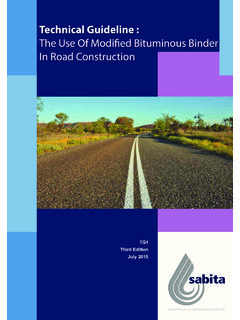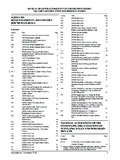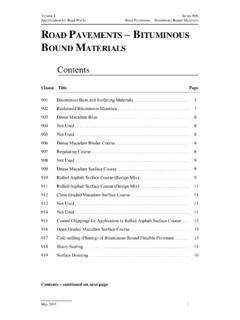Transcription of SAFETY DATA SHEET - iko.ie
1 bituminous Roofing Membranes Version number: 13 Date: July 2013 Supercedes: May 2013 Page 1 of 8 SAFETY data SHEET bituminous Roofing Membranes This SAFETY data SHEET contains information concerning the potential risks to those involved in handling, transporting and working with the material, as well as describing potential risks to the consumer and the environment. This information must be made available to those who may come into contact with the material or are responsible for the use of the material. This SAFETY data SHEET is prepared in accordance with formatting described in the REACH Regulation (EC) No 1907/2006, and described in CLP Regulation (EC) No 1272/2008. SECTION 1: Identification of the substance/mixture and of the company/undertaking Product identifier bituminous Roofing Membranes (see Section 16 for a full list of products to which this SDS applies) Relevant identified uses of the substance or mixture and uses advised against Roofing membranes.
2 Details of the supplier of the SAFETY data SHEET IKO PLC Appley Lane North Appley Bridge, Wigan Lancashire WN6 9AB Tel: 0844 873 1062 Fax: 0844 873 1067 Emergency telephone number Tel: 0844 412 7228 (available 08:30 to 17:00 weekdays) SECTION 2: Hazards Identification Classification of the substance or mixture Classification in accordance with the Dangerous Preparations Directive 1999/45/EC The product is an article, therefore no classification is required. Classification in accordance with the Classification Labelling and Packaging Regulation EC (no) 1272/2008 The product is an article, therefore no classification is required. Label elements Labelling in accordance with the Classification Labelling and Packaging Regulation EC (no) 1272/2008 None required. Other hazards Under normal conditions of use, this product is not expected to create any unusual emergency hazards. Due to product form, exposure to dusts and fumes is not expected to occur.
3 SECTION 3: Composition / Information on Ingredients Substances Not applicable, product is an article. bituminous Roofing Membranes Version number: 13 Date: July 2013 Supercedes: May 2013 Page 2 of 8 Mixtures The products are not mixtures under the CLP Regulation (EC) No 1272/2008, but are considered to be articles. The products in the range consist of a reinforcing base material coated with bitumen and a surface finish. The base materials include polyester, glass/polyester and glass fibres in SHEET form, some used in conjunction with aluminium foil. The bitumen coating may contain mineral filler and/or synthetic polymers. The fire performance cap sheets have an inert graphite coating on the upper surface of the base carrier and the fire performance vapour control layers have a fire retardant modified bitumen coating. The surface finish may be sand, talc, mineral granules or polymeric film. SECTION 4: First Aid Measures Description of first aid measures EYE CONTACT: For contact with cold material, small particles, wash thoroughly with water and obtain medical attention if signs of discomfort persist.
4 In case of contact with hot material, flood eye with copious quantities of cold water for 10-15 minutes. Do not try to remove material adhering to the eye. Cover the burn area loosely with a sterile dressing, if available. Seek immediate medical attention. SKIN CONTACT: For contact with hot material, cool the affected area under cold running water for at least 10 minutes. Do not attempt to remove anything from the burn area or apply burn creams or ointments. Material adhering to skin will form a sterile barrier which will fall off after a few days. Cover the burn area loosely with a sterile dressing, if available. Seek immediate medical attention. INHALATION: In case of inhalation of fumes, remove from exposure. If breathing becomes difficult seek medical assistance. INGESTION: If swallowed, rinse mouth with water. Most important symptoms and effects, both acute and delayed Eyes: Particulates produced from cutting, grinding or drilling of the product may cause mechanical irritation of the eye.
5 Hot melt products may cause thermal burns. Skin: This product may produce skin abrasions. Mechanical rubbing may increase skin irritation. Hot melt products may cause thermal burns. Ingestion: Not a likely route of entry. Inhalation: Inhalation of dusts produced during cutting, grinding or sanding of this product or fumes from hot melt products may cause irritation of the mouth and nose and coughing. Indication of any immediate medical attention and special treatments needed Symptomatic treatment as required SECTION 5: Firefighting Measures Extinguishing media Use any media suitable for the surrounding fires. Water, spray, fog, carbon dioxide (CO2), dry chemical, foam. Special hazards arising from the substance or mixture Standard bitumen based roofing membranes are combustible and release dense black smoke when they burn. Fire performance membranes such as Ultra prevENt, Mach One and Safestick cap sheets have an inert graphite coating on the upper surface of the base carrier, which when installed produces a significant reduction in the capacity of the product to burn and reduces smoke emission in a fire situation Advice for fire fighters Firefighters should wear full-face, self-contained breathing apparatus and impervious protective clothing.
6 Firefighters should avoid inhaling any combustion products. Do not release chemically contaminated water into drains, soil or surface water. SECTION 6: Accidental Release Measures Personal precautions, protective equipment and emergency procedures bituminous Roofing Membranes Version number: 13 Date: July 2013 Supercedes: May 2013 Page 3 of 8 None usually necessary. If there are significant quantities of dust/shavings wear SAFETY glasses with side-shields or SAFETY goggles and gloves. Environmental precautions None usually necessary Methods and materials for containment and clearing up Sweep up or gather material and place in appropriate container for disposal. References to other sections See sections 8 and 13 for further advice on protective clothing and disposal. SECTION 7: Handling and Storage Precautions for safe handling Customary personal hygiene measures, such as washing hands after working with these products are recommended.
7 If dusts or fumes of this product are generated, avoid inhalation, skin and eye contact. Conditions for safe storage, including any incompatibilities Room temperature - normal conditions. Warehouse storage should be in accordance with package directions. Material should be kept dry, and protected from the elements. Specific end uses(s) No special requirements. SECTION 8. Exposure Controls/Personal Protection Control parameters No specific exposure limits available. If process generated dusts or fumes are likely, follow workplace regulatory exposure limits for relevant hazards ( total dust, respirable dust, silica, talc, asphalt fumes). See Annex 1 for further information. Exposure controls Engineering Controls: No special protective measures are necessary for use of this product in that it is an article, and under normal conditions of use is not expected to release, or otherwise result in exposure to a hazardous chemical.
8 If cutting, grinding, drilling, etc. ensure that there is adequate ventilation to keep dust levels within required limits. Personal Protective Equipment: Eyes/Face: Where there is a risk of damage to the eyes/face from splashing of hot product or impact, wear eye/face protection to EN166. Skin: The use of heavy duty gloves to protect against skin abrasion and burns through contact with hot bitumen or flame of gas torch during installation is recommended. Respiratory: Not required under normal conditions of use. If dust or fumes are generated, wear appropriate respiratory protection. Environmental Exposure Controls: Not usually required. SECTION 9: Physical and Chemical Properties Information on basic physical and chemical properties Appearance: Grey black toned solid material. A variety of coloured slate finishes are available on top layer felts. Odour: None Odour threshold: Not Applicable pH: Not Applicable bituminous Roofing Membranes Version number: 13 Date: July 2013 Supercedes: May 2013 Page 4 of 8 Boiling Point: Not Applicable Melting Point: Not applicable Flash Point: Not Applicable Evaporation rate: Not Applicable Flammability(gas, solids): Standard bitumen based roofing membranes are combustible.
9 Fire performance membranes have a significantly reduced capacity to burn. Upper/lower flammability limits: Not Applicable Vapour Pressure: Not Applicable Vapour Density: Not Applicable Specific Gravity: Not applicable Solubility (H2O): Not soluble Solubility in other solvents: Not Applicable Auto Ignition Temp.: No data Decomposition temperature: No data Viscosity: Not Applicable Explosive properties: Not classified as explosive Oxidising properties: Not classified as oxidising Other information None SECTION 10: Chemical Stability and Reactivity Reactivity Not considered a reactive material. Chemical stability Stable under normal conditions. Possibility of hazardous reactions None expected. Conditions to avoid None identified. Incompatible materials None identified. Hazardous decomposition products Bitumen fumes and dense black smoke if heated to excessive temperatures. SECTION 11: Toxicological Information Information on toxicological effects This product has not been tested.
10 Judgements on the expected toxicity of this product have been made based upon consideration of its major components. (a) acute toxicity Not expected to present an acute toxicity hazard. Inhalation of fumes may result in irritation, especially if the product is overheated above recommended temperatures (b) skin corrosion/irritation Mechanical abrasion may occur in contact with skin. Thermal burns when handled at elevated temperatures. (c) serious eye damage/irritation Not expected to present a hazard to the eyes. Mechanical irritation may occur in contact with particles. Thermal burns when handled at elevated temperatures. (d) respiratory/skin sensitisation Not considered to be a skin or respiratory sensitiser (e) germ cell mutagenicity Contains no components known to be mutagenic. bituminous Roofing Membranes Version number: 13 Date: July 2013 Supercedes: May 2013 Page 5 of 8 (f) carcinogenicity Bitumen may contain substances including polyaromatic hydrocarbons (PAHs), some types of which have been associated with cancer.








